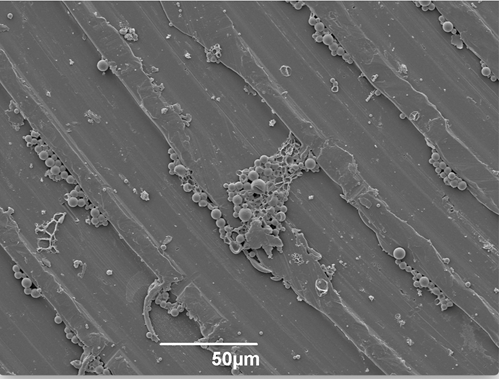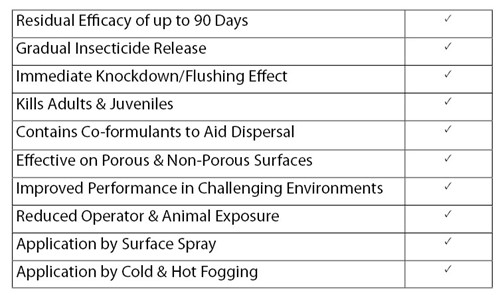Poultry pests: Dealing with the threat from Red Mites and Litter Beetles in poultry houses
02 November 2022
Controlling the two most common poultry house pests can be a tricky business.
Both of these pests thrive in the tightly controlled environmental conditions associated with poultry production. This, along with their fast breeding cycles, means infestations can develop very quickly. It is estimated that, typically, there could be up to 1000 litter beetles per square metre in a poultry house, so it's easy to see how the problem could get out of control.
Infestations of either species affect bird welfare. The pests are known to bite the birds and even chew the base of their feathers. The presence of the pests leads to an increase in the transmission of pathogens associated with human and animal diseases. Both species can impact the general health of birds, lower their performance, devalue meat and eggs, and in the case of litter beetles, cause significant insulation damage. Litter beetles are also known to impact costs by eating the poultry feed.
Ultimately, having too many of these pests in poultry houses adversely affects a producer's bottom line. Profit margins are notoriously tight in this industry and with a surging energy market and inflationary pressures in feed prices, the pests are particularly unwelcome.
Methods of Control
For red mites and litter beetles, prevention is the most effective means of control. Biosecurity measures, proofing and proper disposal of used litter/bedding should all form part of the prevention plan. Careful monitoring of populations can identify the pests early and prevent large scale infestations.
If red mites or litter beetles are present, residual insecticides should also be considered, to enable longer term control and to stop population growth.
Choosing the Right Insecticide
When using insecticide treatments, producers must consider the lifecycle of the pests, environmental conditions and the type of surface on which the product is to be applied. For both red mites and litter beetles, an insecticide must work equally well on porous and non-porous surfaces. Common insecticide formulations such as emulsifiable concentrates (ECs) provide a residual layer on non-porous surfaces but will penetrate porous surfaces, often leaving insufficient doses at the surface level.
Lifecycle
Also to be considered is how to tackle multiple generations of the pest. Without a residual effect, the mature insects will be treated but not the future generations – meaning infestations will return. A chosen insecticide must be as effective at killing the ‘unseen’ larvae and nymphs as it is at killing the matured insects.
Upon application of Mostyn Duo CS, Prallethrin will penetrate cracks and crevices which may act as harbourage areas, whilst the capsules containing Cyphenothrin will remain at surface level. Prallethrin is a Type-I pyrethroid which causes overstimulation of the pests' nervous system, bringing about rapid involuntarily movement. This overstimulation in turn leads to ‘flushing’ of the pests from their harbourages. Cyphenothrin, on the other hand, is a Type-II pyrethroid, a more potent insecticide. The overstimulation caused by Prallethrin increases the amount of contact with Cyphenothrin-treated surfaces, leading to a higher kill rate.
In optimum laboratory conditions, red mites are reported to complete their lifecycle in as little as 7 days; however, even in the favourable conditions of a poultry house, it is likely that the lifecycle is extended to approximately 14 days. Meanwhile, comparably, litter beetles have a significantly longer lifecycle of approximately 45 to 65 days. Insecticide residues should span the timeline of these lifecycles to reach multiple generations.
Mostyn Duo: Cyphenothrin & Prallethrin ZW
Mostyn Duo is a specialised, water-based insecticide formulated as a ZW combination. Within this, Cyphenothrin is suspended in capsules of varying sizes (CS) and dispersed throughout the water phase and Prallethrin is evenly dispersed as fine globules in an emulsion-in-water (EW). This combination of formulation produces a dual effect; Prallethrin is available immediately upon application leading to a fast-acting response and the Cyphenothrin-containing capsules break down, leading to a slow release over time.

Fig.1 In poultry houses the presence of dust, moisture, dirt and other potential contaminants present problems for applying insecticides - and particularly for it remaining on surfaces. It’s crucial that a lethal dose is applied for maximum short-term results and also to reduce the risk of resistance. This image shows how Mostyn Duo in microencapsulated form stays even on porous surfaces for a slow release.
Longer Residual Efficacy
The microcapsules in Mostyn Duo vary in diameter and thickness meaning they break down over time, crucially at different rates, beginning with the thinnest rupturing upon application. This differing rate of breakdown produces a timed response and means that a consistent concentration of killing agent remains on surfaces for longer periods of time.
Another effect of the Cyphenothrin being held in capsules is that it is protected from the accumulation of dust, dirt and moisture which may otherwise prematurely degrade the insecticide. Similarly, the co-formulants incorporated in the capsule walls ensure degradation caused by oxidation and UV light is minimised.

Fig 2. Upon application, Prallethrin will penetrate cracks and crevices which may act as harbourage areas, whilst the capsules containing Cyphenothrin will remain at surface level.
Key Features

The longevity and consistency of Mostyn Duo makes it an essential tool for winning the war against these pests and maximising welfare and productivity in poultry houses. Mostyn Duo is non staining and odourless.
Trial Data
Simulated Use Trial: Spray Application
The trial was conducted in four 12m3 test chambers with simulated real conditions of use. Insects were released and their mortality observed after 24 hours of exposure.
The results revealed a full elimination (100% mortality) within 24 hours. When the treated panels were reintroduced to a fresh batch of the pests 12 weeks later, 100% mortality was again observed. This shows very good residual efficacy against both litter beetles and red mites.
Simulated Use Trial: Cold and Thermal Fog Applications
These trials were conducted in a 500m3 test chamber (100m2 floor area; 5m high) and under controlled climatic conditions. Red mites tested were from a wild infestation and had been acclimatised for 7 days in the lab with manure from the original breeding.
The product efficacy revealed that the complete killing rate (at 100%) after 24 hours shows Mostyn Duo to be a curative treatment against litter beetles and poultry red mites in both cold fogging and hot fogging applications, from a dose of 100 ml in 500m3.
Field Trial: Litter Beetle Infested Broiler Sheds
Three commercial broiler sheds containing a total of 70,000 birds received 4 treatments of Mostyn Duo over 2 production cycles. Treatments occurred after bird removal, one prior to cleaning and disinfection and a second prior to the flock being introduced.
For each treatment, Mostyn Duo was applied as a band spray to the interior and exterior perimeter walls of the poultry sheds. In addition, particular attention was paid to the space directly under the roof, alongside windows, doors and ventilation points.
Pre-treatment monitoring from 10 traps over 3 sites totalled 18,535 adults and 3,402 larvae. Populations were monitored again in the last week of the second production cycle (18 weeks after the initial recordings). Adult litter beetles totalled 493 over the 10 traps and larvae totalled 729.
For full details of the trials and conditions read the full report. For more information about the product view the product page here or contact our team for more info.
